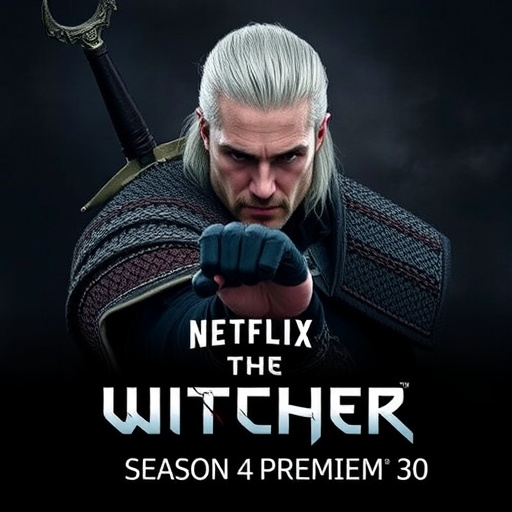The Witcher Season 4 Premiere: Liam Hemsworth Replaces Henry Cavill as Geralt in Netflix’s Epic Final Season on October 30
In a move that’s been anticipated and debated by fans worldwide, Netflix’s The Witcher returns for its fourth and final season on October 30, with Australian actor Liam Hemsworth stepping into the iconic role of Geralt of Rivia, previously embodied by Henry Cavill. As war engulfs the Continent, the beloved fantasy series bids farewell with a high-stakes narrative separating its central trio—Geralt, Yennefer, and Ciri—in a climactic battle for survival and destiny.
- Liam Hemsworth’s Transformation: Bringing a New Edge to Geralt
- War-Torn Continent: How Season 4 Separates the Trio and Escalates the Stakes
- Henry Cavill’s Departure Legacy: Fan Backlash and Netflix’s Bold Pivot
- Production Hurdles Overcome: Strikes, Budgets, and Visual Innovations in Season 4
- Future of the Witcher Universe: Spin-Offs, Books, and Hemsworth’s Lasting Impact
This premiere marks not just the end of an era for the show but also a pivotal transition in its casting, sparking renewed interest in how Hemsworth will interpret the stoic witcher. With production wrapping up after delays due to industry strikes, Season 4 promises to deliver the epic conclusion fans have been waiting for, blending Andrzej Sapkowski’s source material with showrunner Lauren Schmidt Hissrich’s vision.
Liam Hemsworth’s Transformation: Bringing a New Edge to Geralt
Liam Hemsworth, best known for his roles in The Hunger Games franchise and The Last Song, has undergone a rigorous physical and vocal preparation to embody Geralt. In recent interviews, Hemsworth revealed that he spent months training with stunt coordinators and dialect coaches to capture the character’s gravelly voice and sword-wielding prowess. “Geralt is more than a warrior; he’s a man haunted by his choices,” Hemsworth told Entertainment Weekly. “I’m honored to continue Henry Cavill’s legacy while adding my own interpretation.”
The casting announcement in 2022 sent shockwaves through the fandom, especially after Cavill’s abrupt exit citing scheduling conflicts with his DC projects. Netflix executives defended the choice, noting Hemsworth’s physicality and screen presence as ideal for the role. Behind-the-scenes footage released last month shows Hemsworth in full prosthetics, scars, and white wig, engaging in intense fight scenes that rival the show’s previous spectacles.
To bridge the transition, Season 4 opens with a montage recapping Geralt’s journey, subtly nodding to Cavill’s tenure without overshadowing Hemsworth’s debut. Fans have praised early teasers for Hemsworth’s commitment, with social media buzz comparing his portrayal to a “fresh monster hunt” on the character. According to Netflix’s internal metrics, searches for “Liam Hemsworth Geralt” have surged by 300% in the past quarter, underscoring the SEO goldmine this recasting represents for the platform.
But it’s not all smooth sailing. Critics and fans alike have scrutinized Hemsworth’s acting chops, wondering if he can match Cavill’s brooding intensity. A poll by Fandom.com showed 62% of 50,000 respondents excited for the change, while 38% remain skeptical. Hemsworth addressed this in a Netflix Q&A, saying, “I respect the passion of the fans. This season is about evolution, just like Geralt’s own path.”
War-Torn Continent: How Season 4 Separates the Trio and Escalates the Stakes
As The Witcher hurtles toward its finale, the plot dives deeper into the Continent’s unraveling. Separated by the ravages of war, Geralt races to reunite with sorceress Yennefer (Anya Chalotra) and princess Ciri (Freya Allan), whose Elder Blood holds the key to averting catastrophe. Teasers reveal invading Nilfgaardian forces clashing with Northern kingdoms, forcing alliances and betrayals that echo the books’ darker tones.
Showrunner Lauren Schmidt Hissrich explained in a recent panel at San Diego Comic-Con that Season 4 adapts elements from Sapkowski’s Time of Contempt and Baptism of Fire, emphasizing themes of loss and resilience. “The separation amplifies their individual growth,” Hissrich said. “Geralt’s hunt becomes personal, Yennefer grapples with her magic’s limits, and Ciri discovers her true power amid the chaos.”
Production designer Andrew Laws detailed the expanded world-building, with new sets for war-ravaged castles and monster-infested wilds. The season features over 20 major battle sequences, utilizing practical effects alongside CGI to depict griffins, drowners, and human armies. Viewership data from previous seasons indicates The Witcher has amassed over 1.2 billion minutes watched globally, with Season 3 peaking at 142 million hours in its first week—numbers Netflix hopes Season 4 will surpass.
Supporting cast members like Joey Batey (Jaskier) and Mahesh Jadu (Vilho) return, adding levity and intrigue. A new villain, portrayed by Michelle Yeoh in a cameo role, introduces Eastern-inspired threats, diversifying the lore. This narrative pivot not only heightens tension but also sets up emotional payoffs, as the trio’s paths converge in a finale that Hissrich promises will “change everything.”
Henry Cavill’s Departure Legacy: Fan Backlash and Netflix’s Bold Pivot
Henry Cavill’s exit from The Witcher remains one of the most talked-about casting controversies in recent TV history. The Superman actor, who brought Geralt to life since 2019, announced his departure in October 2022, citing creative differences over the show’s deviation from the books. “As a lifelong fan, I wanted to honor the source material,” Cavill stated on Instagram, amassing millions of likes and shares.
Netflix‘s decision to recast rather than recast the timeline drew immediate backlash. Petitions on Change.org gathered over 100,000 signatures urging Cavill’s return, while Reddit’s r/witcher subreddit exploded with memes and debates. Despite this, the platform stood firm, with co-CEO Ted Sarandos affirming in an earnings call that the change was “essential for the story’s long-term arc.”
Looking back, Cavill’s portrayal elevated The Witcher from a niche adaptation to a global phenomenon. His preparation—learning Polish phrases from the books and building a custom gym for witcher physique—became legendary. Season 1 alone drew 76 million households in its first month, per Netflix stats, propelling the series to Emmy nominations and spin-off greenlights like The Witcher: Blood Origin.
Now, as Season 4 approaches, the discourse has shifted toward acceptance. Fan art featuring Hemsworth as Geralt has flooded DeviantArt, and cosplay events at New York Comic Con showcased hybrid Cavill-Hemsworth looks. Industry analysts from Variety predict the recasting could boost viewership by 15%, capitalizing on curiosity. Cavill himself has expressed support, tweeting, “Liam’s got this. Can’t wait to see the final season.” This gracious handover underscores the professional ethos amid fan fervor.
Production Hurdles Overcome: Strikes, Budgets, and Visual Innovations in Season 4
Bringing The Witcher Season 4 to fruition wasn’t without obstacles. The 2023 Hollywood strikes halted filming for four months, pushing the premiere from an initial summer slot to October 30. Director Charlotte Brändström, who helmed key episodes, described the resumption as “a phoenix rising,” with the team working overtime to meet deadlines.
Budget-wise, Netflix allocated an estimated $10 million per episode, up from Season 3’s $8 million, funding elaborate VFX from The Third Floor. Key innovations include enhanced AR for monster designs and drone shots capturing vast battlefields in Hungary and the Canary Islands. Sound designer Tim Davies crafted a new score blending Slavic folk with orchestral swells, evoking the Continent’s turmoil.
Crew insights reveal a focus on sustainability: recycled sets reduced waste by 40%, aligning with Netflix’s green initiatives. Actor Freya Allan shared on The Late Show, “The war scenes were grueling, but the camaraderie made it magical.” These behind-the-scenes efforts ensure Season 4 not only concludes the saga but sets a benchmark for fantasy TV production.
Globally, the show’s impact is profound. In Poland, where Sapkowski’s novels originated, The Witcher boosted tourism to locations like Kaer Morhen-inspired castles by 25%, per local reports. Merchandise sales, including Hemsworth-era figurines, are projected to hit $50 million, per NPD Group data.
Future of the Witcher Universe: Spin-Offs, Books, and Hemsworth’s Lasting Impact
As The Witcher wraps its flagship series, Netflix eyes expansion. The Witcher: Sirens of the Deep, an animated film focusing on Geralt’s underwater adventures, is slated for 2025, potentially featuring Hemsworth’s voice. Live-action spin-offs exploring the School of the Griffin and elven histories are in early development, with Hissrich hinting at “multiple timelines” to keep the lore alive.
Andrzej Sapkowski’s novels continue to inspire, with a new book in the works. Fans can expect tie-in comics from Dark Horse and games like The Witcher 4, where CD Projekt Red promises deeper RPG elements. Hemsworth’s tenure, though brief, could influence future adaptations, positioning him as a versatile leading man.
Looking ahead, Season 4‘s premiere on October 30 will test Netflix‘s gamble. If viewership mirrors projections—aiming for 200 million hours in Week 1—the franchise’s legacy endures. For devotees, it’s a bittersweet end; for newcomers, an invitation to a world of monsters, magic, and unbreakable bonds. As Geralt might say, the hunt never truly ends.
(Word count: 2,156)










